Comprehensive Report: Loneliness of Elders in UK Care Homes
VerifiedAdded on 2020/07/22
|11
|3514
|27
Report
AI Summary
This report delves into the significant public health issue of loneliness among elders residing in care homes in the UK. It explores the critical role of nurses in implementing health promotion strategies and public health interventions to combat social isolation and improve the well-being of elderly residents. The report examines various intervention strategies, including social skill training, social support programs, and collaborative healthcare planning. Furthermore, it analyzes the impact of political, social, economic, and cultural factors on public health within care home settings. The report emphasizes the need for effective communication and personal skills in healthcare planning to address the diverse needs of residents, highlighting the importance of both group and individual interventions. It concludes by underscoring the necessity for comprehensive strategies to mitigate loneliness and improve the quality of life for elders in care homes.
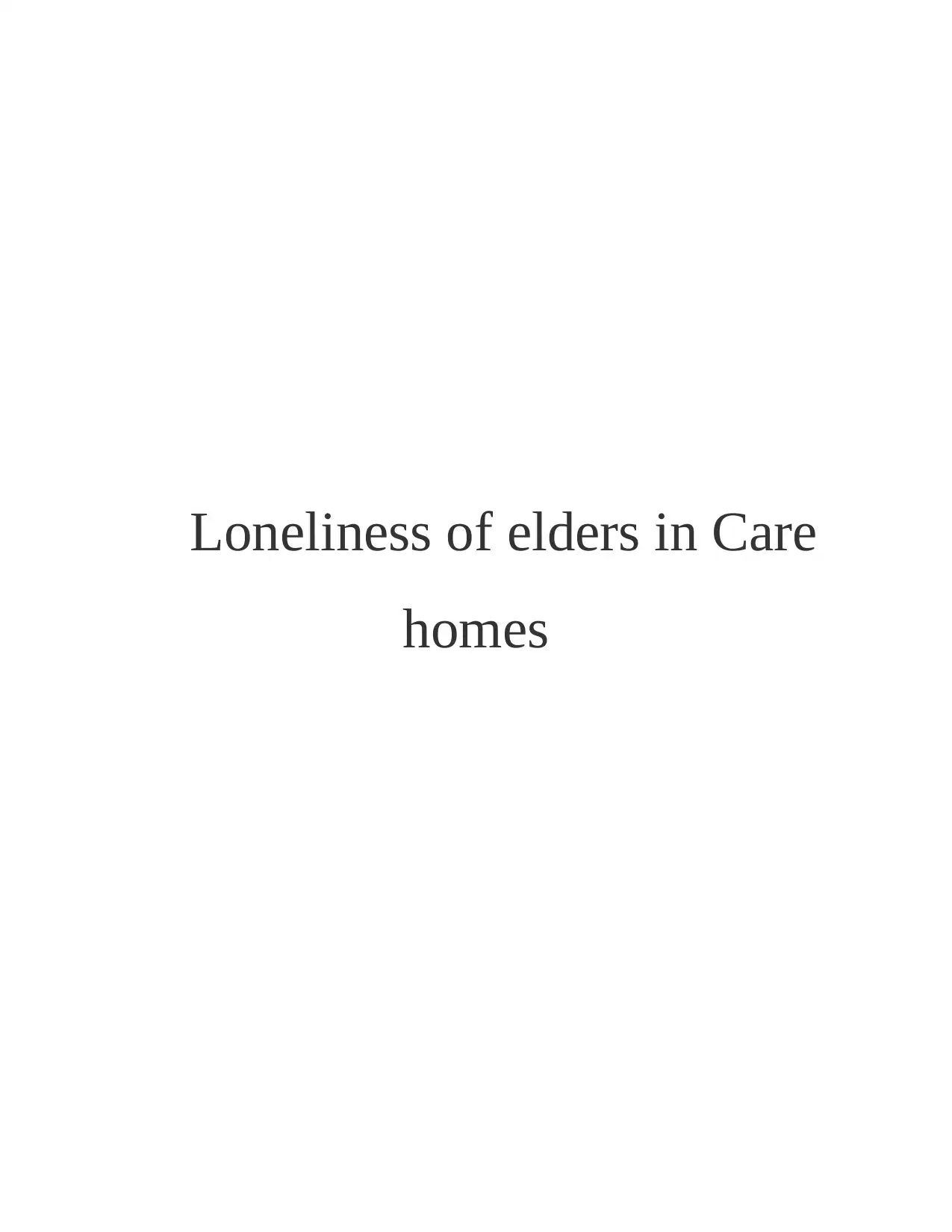
Loneliness of elders in Care
homes
homes
Paraphrase This Document
Need a fresh take? Get an instant paraphrase of this document with our AI Paraphraser
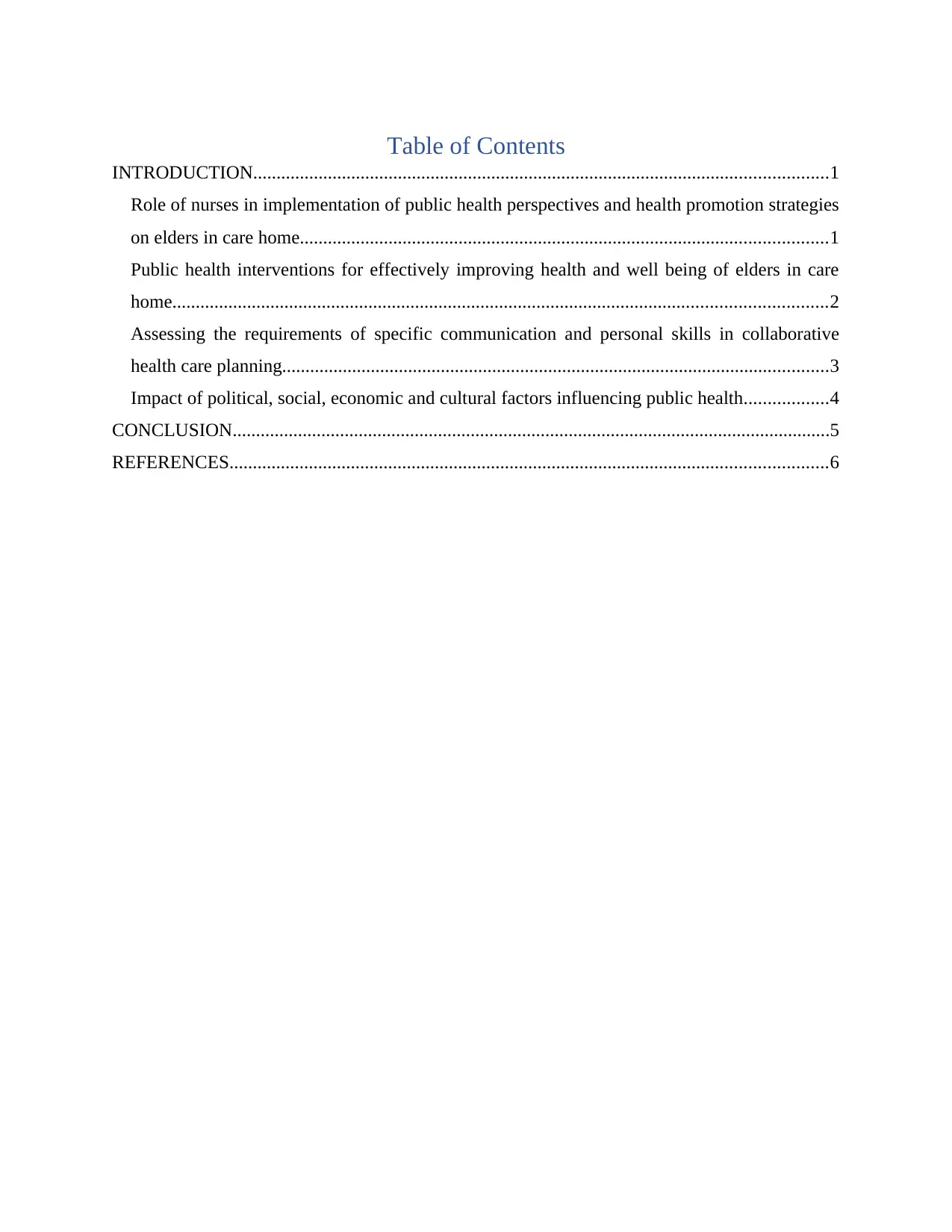
Table of Contents
INTRODUCTION...........................................................................................................................1
Role of nurses in implementation of public health perspectives and health promotion strategies
on elders in care home.................................................................................................................1
Public health interventions for effectively improving health and well being of elders in care
home............................................................................................................................................2
Assessing the requirements of specific communication and personal skills in collaborative
health care planning.....................................................................................................................3
Impact of political, social, economic and cultural factors influencing public health..................4
CONCLUSION................................................................................................................................5
REFERENCES................................................................................................................................6
INTRODUCTION...........................................................................................................................1
Role of nurses in implementation of public health perspectives and health promotion strategies
on elders in care home.................................................................................................................1
Public health interventions for effectively improving health and well being of elders in care
home............................................................................................................................................2
Assessing the requirements of specific communication and personal skills in collaborative
health care planning.....................................................................................................................3
Impact of political, social, economic and cultural factors influencing public health..................4
CONCLUSION................................................................................................................................5
REFERENCES................................................................................................................................6
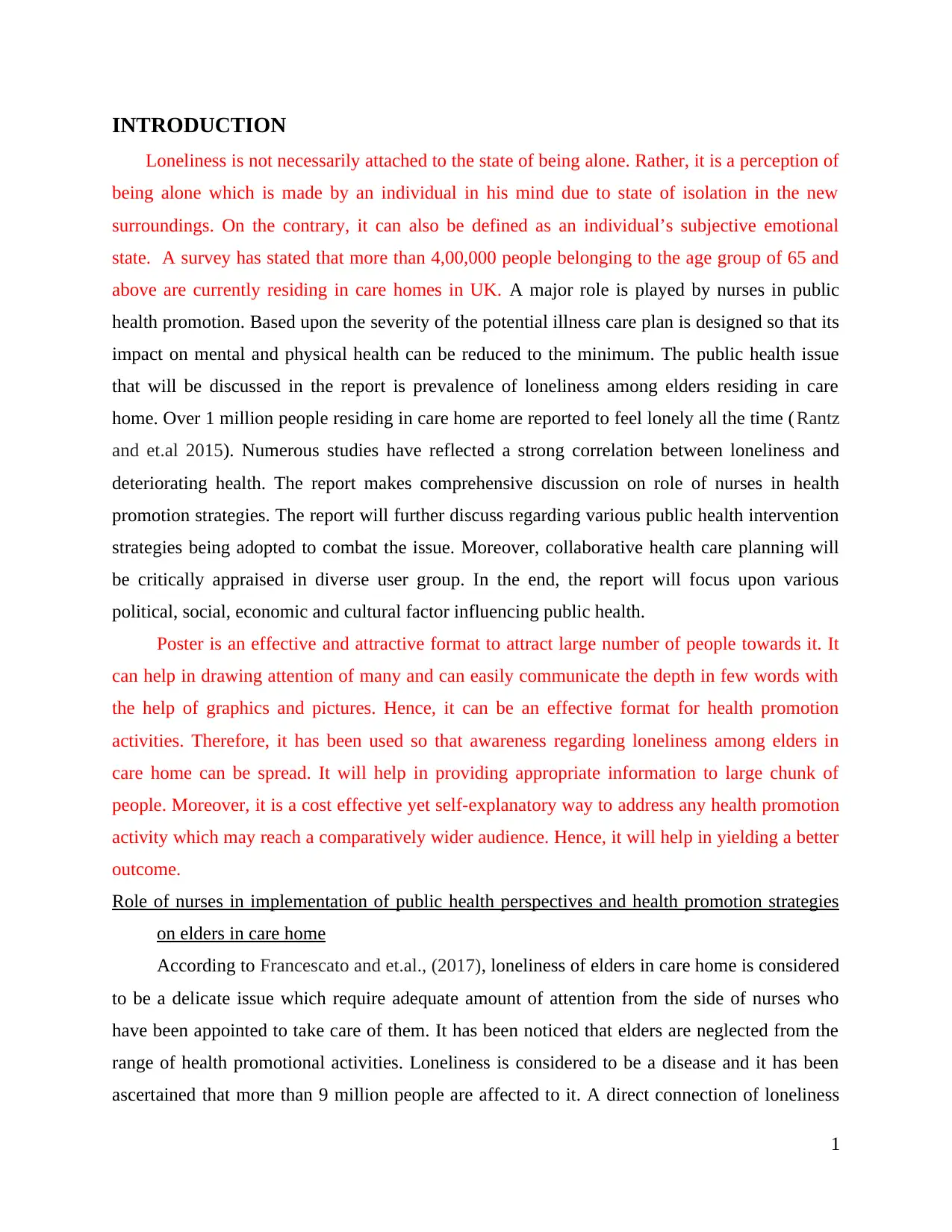
INTRODUCTION
Loneliness is not necessarily attached to the state of being alone. Rather, it is a perception of
being alone which is made by an individual in his mind due to state of isolation in the new
surroundings. On the contrary, it can also be defined as an individual’s subjective emotional
state. A survey has stated that more than 4,00,000 people belonging to the age group of 65 and
above are currently residing in care homes in UK. A major role is played by nurses in public
health promotion. Based upon the severity of the potential illness care plan is designed so that its
impact on mental and physical health can be reduced to the minimum. The public health issue
that will be discussed in the report is prevalence of loneliness among elders residing in care
home. Over 1 million people residing in care home are reported to feel lonely all the time ( Rantz
and et.al 2015). Numerous studies have reflected a strong correlation between loneliness and
deteriorating health. The report makes comprehensive discussion on role of nurses in health
promotion strategies. The report will further discuss regarding various public health intervention
strategies being adopted to combat the issue. Moreover, collaborative health care planning will
be critically appraised in diverse user group. In the end, the report will focus upon various
political, social, economic and cultural factor influencing public health.
Poster is an effective and attractive format to attract large number of people towards it. It
can help in drawing attention of many and can easily communicate the depth in few words with
the help of graphics and pictures. Hence, it can be an effective format for health promotion
activities. Therefore, it has been used so that awareness regarding loneliness among elders in
care home can be spread. It will help in providing appropriate information to large chunk of
people. Moreover, it is a cost effective yet self-explanatory way to address any health promotion
activity which may reach a comparatively wider audience. Hence, it will help in yielding a better
outcome.
Role of nurses in implementation of public health perspectives and health promotion strategies
on elders in care home
According to Francescato and et.al., (2017), loneliness of elders in care home is considered
to be a delicate issue which require adequate amount of attention from the side of nurses who
have been appointed to take care of them. It has been noticed that elders are neglected from the
range of health promotional activities. Loneliness is considered to be a disease and it has been
ascertained that more than 9 million people are affected to it. A direct connection of loneliness
1
Loneliness is not necessarily attached to the state of being alone. Rather, it is a perception of
being alone which is made by an individual in his mind due to state of isolation in the new
surroundings. On the contrary, it can also be defined as an individual’s subjective emotional
state. A survey has stated that more than 4,00,000 people belonging to the age group of 65 and
above are currently residing in care homes in UK. A major role is played by nurses in public
health promotion. Based upon the severity of the potential illness care plan is designed so that its
impact on mental and physical health can be reduced to the minimum. The public health issue
that will be discussed in the report is prevalence of loneliness among elders residing in care
home. Over 1 million people residing in care home are reported to feel lonely all the time ( Rantz
and et.al 2015). Numerous studies have reflected a strong correlation between loneliness and
deteriorating health. The report makes comprehensive discussion on role of nurses in health
promotion strategies. The report will further discuss regarding various public health intervention
strategies being adopted to combat the issue. Moreover, collaborative health care planning will
be critically appraised in diverse user group. In the end, the report will focus upon various
political, social, economic and cultural factor influencing public health.
Poster is an effective and attractive format to attract large number of people towards it. It
can help in drawing attention of many and can easily communicate the depth in few words with
the help of graphics and pictures. Hence, it can be an effective format for health promotion
activities. Therefore, it has been used so that awareness regarding loneliness among elders in
care home can be spread. It will help in providing appropriate information to large chunk of
people. Moreover, it is a cost effective yet self-explanatory way to address any health promotion
activity which may reach a comparatively wider audience. Hence, it will help in yielding a better
outcome.
Role of nurses in implementation of public health perspectives and health promotion strategies
on elders in care home
According to Francescato and et.al., (2017), loneliness of elders in care home is considered
to be a delicate issue which require adequate amount of attention from the side of nurses who
have been appointed to take care of them. It has been noticed that elders are neglected from the
range of health promotional activities. Loneliness is considered to be a disease and it has been
ascertained that more than 9 million people are affected to it. A direct connection of loneliness
1
⊘ This is a preview!⊘
Do you want full access?
Subscribe today to unlock all pages.

Trusted by 1+ million students worldwide
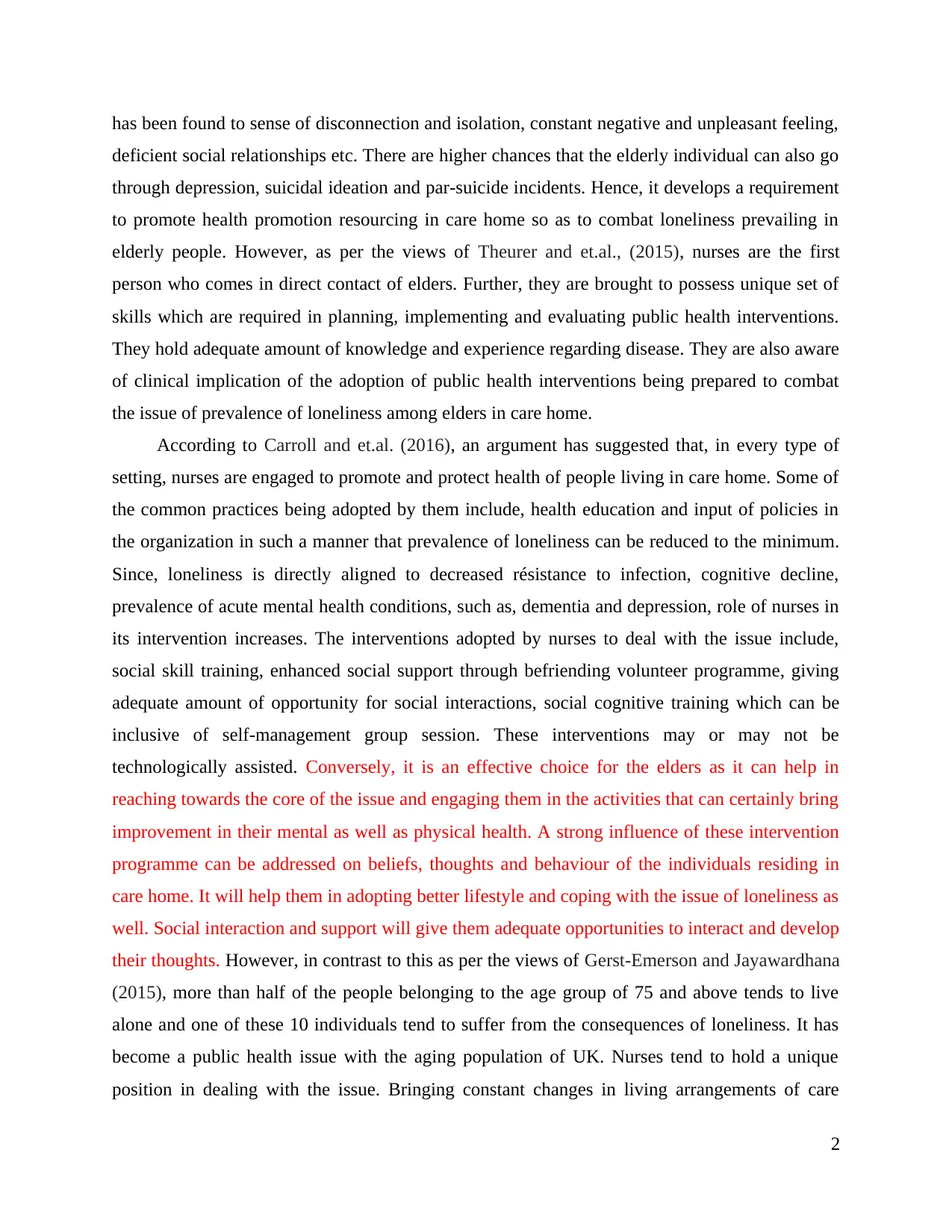
has been found to sense of disconnection and isolation, constant negative and unpleasant feeling,
deficient social relationships etc. There are higher chances that the elderly individual can also go
through depression, suicidal ideation and par-suicide incidents. Hence, it develops a requirement
to promote health promotion resourcing in care home so as to combat loneliness prevailing in
elderly people. However, as per the views of Theurer and et.al., (2015), nurses are the first
person who comes in direct contact of elders. Further, they are brought to possess unique set of
skills which are required in planning, implementing and evaluating public health interventions.
They hold adequate amount of knowledge and experience regarding disease. They are also aware
of clinical implication of the adoption of public health interventions being prepared to combat
the issue of prevalence of loneliness among elders in care home.
According to Carroll and et.al. (2016), an argument has suggested that, in every type of
setting, nurses are engaged to promote and protect health of people living in care home. Some of
the common practices being adopted by them include, health education and input of policies in
the organization in such a manner that prevalence of loneliness can be reduced to the minimum.
Since, loneliness is directly aligned to decreased résistance to infection, cognitive decline,
prevalence of acute mental health conditions, such as, dementia and depression, role of nurses in
its intervention increases. The interventions adopted by nurses to deal with the issue include,
social skill training, enhanced social support through befriending volunteer programme, giving
adequate amount of opportunity for social interactions, social cognitive training which can be
inclusive of self-management group session. These interventions may or may not be
technologically assisted. Conversely, it is an effective choice for the elders as it can help in
reaching towards the core of the issue and engaging them in the activities that can certainly bring
improvement in their mental as well as physical health. A strong influence of these intervention
programme can be addressed on beliefs, thoughts and behaviour of the individuals residing in
care home. It will help them in adopting better lifestyle and coping with the issue of loneliness as
well. Social interaction and support will give them adequate opportunities to interact and develop
their thoughts. However, in contrast to this as per the views of Gerst-Emerson and Jayawardhana
(2015), more than half of the people belonging to the age group of 75 and above tends to live
alone and one of these 10 individuals tend to suffer from the consequences of loneliness. It has
become a public health issue with the aging population of UK. Nurses tend to hold a unique
position in dealing with the issue. Bringing constant changes in living arrangements of care
2
deficient social relationships etc. There are higher chances that the elderly individual can also go
through depression, suicidal ideation and par-suicide incidents. Hence, it develops a requirement
to promote health promotion resourcing in care home so as to combat loneliness prevailing in
elderly people. However, as per the views of Theurer and et.al., (2015), nurses are the first
person who comes in direct contact of elders. Further, they are brought to possess unique set of
skills which are required in planning, implementing and evaluating public health interventions.
They hold adequate amount of knowledge and experience regarding disease. They are also aware
of clinical implication of the adoption of public health interventions being prepared to combat
the issue of prevalence of loneliness among elders in care home.
According to Carroll and et.al. (2016), an argument has suggested that, in every type of
setting, nurses are engaged to promote and protect health of people living in care home. Some of
the common practices being adopted by them include, health education and input of policies in
the organization in such a manner that prevalence of loneliness can be reduced to the minimum.
Since, loneliness is directly aligned to decreased résistance to infection, cognitive decline,
prevalence of acute mental health conditions, such as, dementia and depression, role of nurses in
its intervention increases. The interventions adopted by nurses to deal with the issue include,
social skill training, enhanced social support through befriending volunteer programme, giving
adequate amount of opportunity for social interactions, social cognitive training which can be
inclusive of self-management group session. These interventions may or may not be
technologically assisted. Conversely, it is an effective choice for the elders as it can help in
reaching towards the core of the issue and engaging them in the activities that can certainly bring
improvement in their mental as well as physical health. A strong influence of these intervention
programme can be addressed on beliefs, thoughts and behaviour of the individuals residing in
care home. It will help them in adopting better lifestyle and coping with the issue of loneliness as
well. Social interaction and support will give them adequate opportunities to interact and develop
their thoughts. However, in contrast to this as per the views of Gerst-Emerson and Jayawardhana
(2015), more than half of the people belonging to the age group of 75 and above tends to live
alone and one of these 10 individuals tend to suffer from the consequences of loneliness. It has
become a public health issue with the aging population of UK. Nurses tend to hold a unique
position in dealing with the issue. Bringing constant changes in living arrangements of care
2
Paraphrase This Document
Need a fresh take? Get an instant paraphrase of this document with our AI Paraphraser
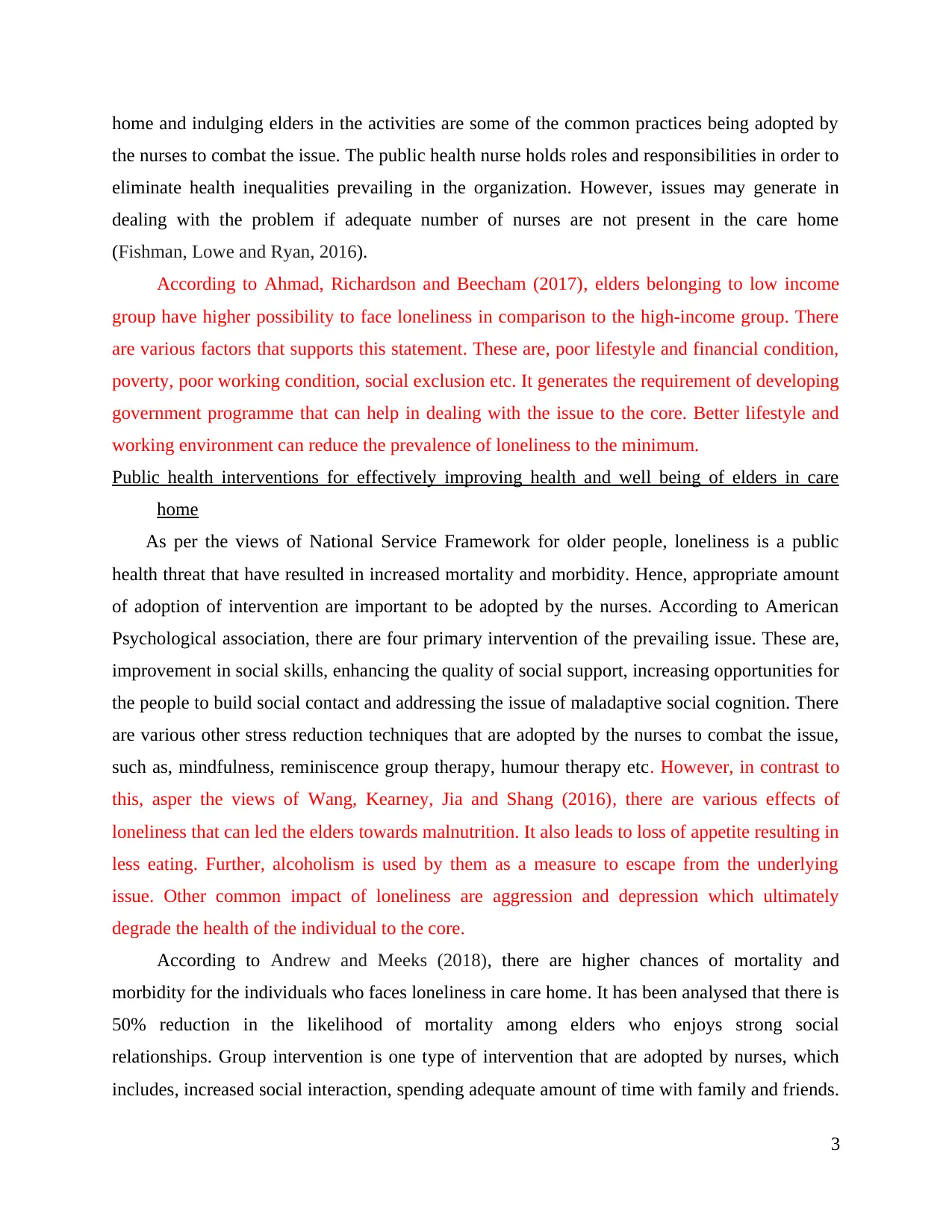
home and indulging elders in the activities are some of the common practices being adopted by
the nurses to combat the issue. The public health nurse holds roles and responsibilities in order to
eliminate health inequalities prevailing in the organization. However, issues may generate in
dealing with the problem if adequate number of nurses are not present in the care home
(Fishman, Lowe and Ryan, 2016).
According to Ahmad, Richardson and Beecham (2017), elders belonging to low income
group have higher possibility to face loneliness in comparison to the high-income group. There
are various factors that supports this statement. These are, poor lifestyle and financial condition,
poverty, poor working condition, social exclusion etc. It generates the requirement of developing
government programme that can help in dealing with the issue to the core. Better lifestyle and
working environment can reduce the prevalence of loneliness to the minimum.
Public health interventions for effectively improving health and well being of elders in care
home
As per the views of National Service Framework for older people, loneliness is a public
health threat that have resulted in increased mortality and morbidity. Hence, appropriate amount
of adoption of intervention are important to be adopted by the nurses. According to American
Psychological association, there are four primary intervention of the prevailing issue. These are,
improvement in social skills, enhancing the quality of social support, increasing opportunities for
the people to build social contact and addressing the issue of maladaptive social cognition. There
are various other stress reduction techniques that are adopted by the nurses to combat the issue,
such as, mindfulness, reminiscence group therapy, humour therapy etc. However, in contrast to
this, asper the views of Wang, Kearney, Jia and Shang (2016), there are various effects of
loneliness that can led the elders towards malnutrition. It also leads to loss of appetite resulting in
less eating. Further, alcoholism is used by them as a measure to escape from the underlying
issue. Other common impact of loneliness are aggression and depression which ultimately
degrade the health of the individual to the core.
According to Andrew and Meeks (2018), there are higher chances of mortality and
morbidity for the individuals who faces loneliness in care home. It has been analysed that there is
50% reduction in the likelihood of mortality among elders who enjoys strong social
relationships. Group intervention is one type of intervention that are adopted by nurses, which
includes, increased social interaction, spending adequate amount of time with family and friends.
3
the nurses to combat the issue. The public health nurse holds roles and responsibilities in order to
eliminate health inequalities prevailing in the organization. However, issues may generate in
dealing with the problem if adequate number of nurses are not present in the care home
(Fishman, Lowe and Ryan, 2016).
According to Ahmad, Richardson and Beecham (2017), elders belonging to low income
group have higher possibility to face loneliness in comparison to the high-income group. There
are various factors that supports this statement. These are, poor lifestyle and financial condition,
poverty, poor working condition, social exclusion etc. It generates the requirement of developing
government programme that can help in dealing with the issue to the core. Better lifestyle and
working environment can reduce the prevalence of loneliness to the minimum.
Public health interventions for effectively improving health and well being of elders in care
home
As per the views of National Service Framework for older people, loneliness is a public
health threat that have resulted in increased mortality and morbidity. Hence, appropriate amount
of adoption of intervention are important to be adopted by the nurses. According to American
Psychological association, there are four primary intervention of the prevailing issue. These are,
improvement in social skills, enhancing the quality of social support, increasing opportunities for
the people to build social contact and addressing the issue of maladaptive social cognition. There
are various other stress reduction techniques that are adopted by the nurses to combat the issue,
such as, mindfulness, reminiscence group therapy, humour therapy etc. However, in contrast to
this, asper the views of Wang, Kearney, Jia and Shang (2016), there are various effects of
loneliness that can led the elders towards malnutrition. It also leads to loss of appetite resulting in
less eating. Further, alcoholism is used by them as a measure to escape from the underlying
issue. Other common impact of loneliness are aggression and depression which ultimately
degrade the health of the individual to the core.
According to Andrew and Meeks (2018), there are higher chances of mortality and
morbidity for the individuals who faces loneliness in care home. It has been analysed that there is
50% reduction in the likelihood of mortality among elders who enjoys strong social
relationships. Group intervention is one type of intervention that are adopted by nurses, which
includes, increased social interaction, spending adequate amount of time with family and friends.
3
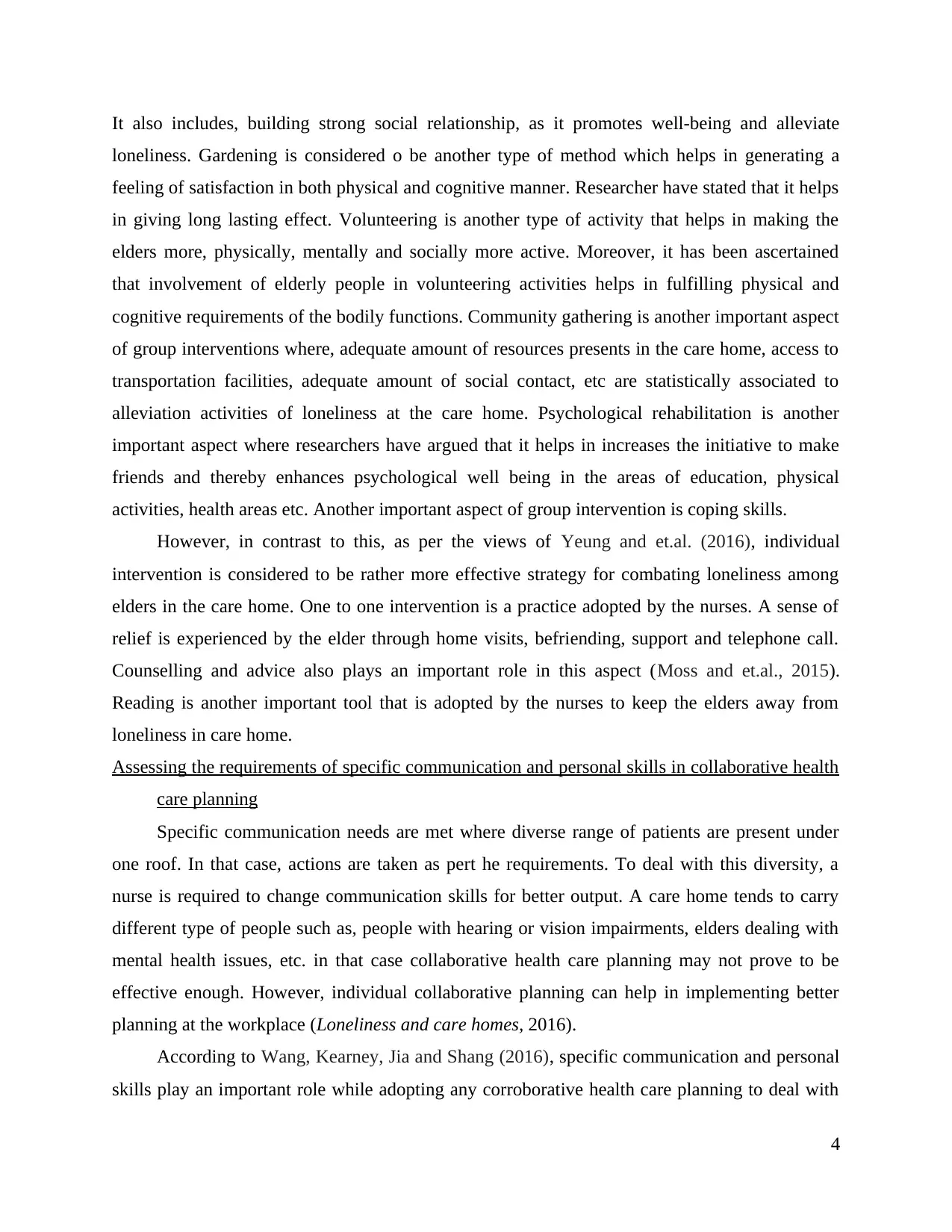
It also includes, building strong social relationship, as it promotes well-being and alleviate
loneliness. Gardening is considered o be another type of method which helps in generating a
feeling of satisfaction in both physical and cognitive manner. Researcher have stated that it helps
in giving long lasting effect. Volunteering is another type of activity that helps in making the
elders more, physically, mentally and socially more active. Moreover, it has been ascertained
that involvement of elderly people in volunteering activities helps in fulfilling physical and
cognitive requirements of the bodily functions. Community gathering is another important aspect
of group interventions where, adequate amount of resources presents in the care home, access to
transportation facilities, adequate amount of social contact, etc are statistically associated to
alleviation activities of loneliness at the care home. Psychological rehabilitation is another
important aspect where researchers have argued that it helps in increases the initiative to make
friends and thereby enhances psychological well being in the areas of education, physical
activities, health areas etc. Another important aspect of group intervention is coping skills.
However, in contrast to this, as per the views of Yeung and et.al. (2016), individual
intervention is considered to be rather more effective strategy for combating loneliness among
elders in the care home. One to one intervention is a practice adopted by the nurses. A sense of
relief is experienced by the elder through home visits, befriending, support and telephone call.
Counselling and advice also plays an important role in this aspect (Moss and et.al., 2015).
Reading is another important tool that is adopted by the nurses to keep the elders away from
loneliness in care home.
Assessing the requirements of specific communication and personal skills in collaborative health
care planning
Specific communication needs are met where diverse range of patients are present under
one roof. In that case, actions are taken as pert he requirements. To deal with this diversity, a
nurse is required to change communication skills for better output. A care home tends to carry
different type of people such as, people with hearing or vision impairments, elders dealing with
mental health issues, etc. in that case collaborative health care planning may not prove to be
effective enough. However, individual collaborative planning can help in implementing better
planning at the workplace (Loneliness and care homes, 2016).
According to Wang, Kearney, Jia and Shang (2016), specific communication and personal
skills play an important role while adopting any corroborative health care planning to deal with
4
loneliness. Gardening is considered o be another type of method which helps in generating a
feeling of satisfaction in both physical and cognitive manner. Researcher have stated that it helps
in giving long lasting effect. Volunteering is another type of activity that helps in making the
elders more, physically, mentally and socially more active. Moreover, it has been ascertained
that involvement of elderly people in volunteering activities helps in fulfilling physical and
cognitive requirements of the bodily functions. Community gathering is another important aspect
of group interventions where, adequate amount of resources presents in the care home, access to
transportation facilities, adequate amount of social contact, etc are statistically associated to
alleviation activities of loneliness at the care home. Psychological rehabilitation is another
important aspect where researchers have argued that it helps in increases the initiative to make
friends and thereby enhances psychological well being in the areas of education, physical
activities, health areas etc. Another important aspect of group intervention is coping skills.
However, in contrast to this, as per the views of Yeung and et.al. (2016), individual
intervention is considered to be rather more effective strategy for combating loneliness among
elders in the care home. One to one intervention is a practice adopted by the nurses. A sense of
relief is experienced by the elder through home visits, befriending, support and telephone call.
Counselling and advice also plays an important role in this aspect (Moss and et.al., 2015).
Reading is another important tool that is adopted by the nurses to keep the elders away from
loneliness in care home.
Assessing the requirements of specific communication and personal skills in collaborative health
care planning
Specific communication needs are met where diverse range of patients are present under
one roof. In that case, actions are taken as pert he requirements. To deal with this diversity, a
nurse is required to change communication skills for better output. A care home tends to carry
different type of people such as, people with hearing or vision impairments, elders dealing with
mental health issues, etc. in that case collaborative health care planning may not prove to be
effective enough. However, individual collaborative planning can help in implementing better
planning at the workplace (Loneliness and care homes, 2016).
According to Wang, Kearney, Jia and Shang (2016), specific communication and personal
skills play an important role while adopting any corroborative health care planning to deal with
4
⊘ This is a preview!⊘
Do you want full access?
Subscribe today to unlock all pages.

Trusted by 1+ million students worldwide
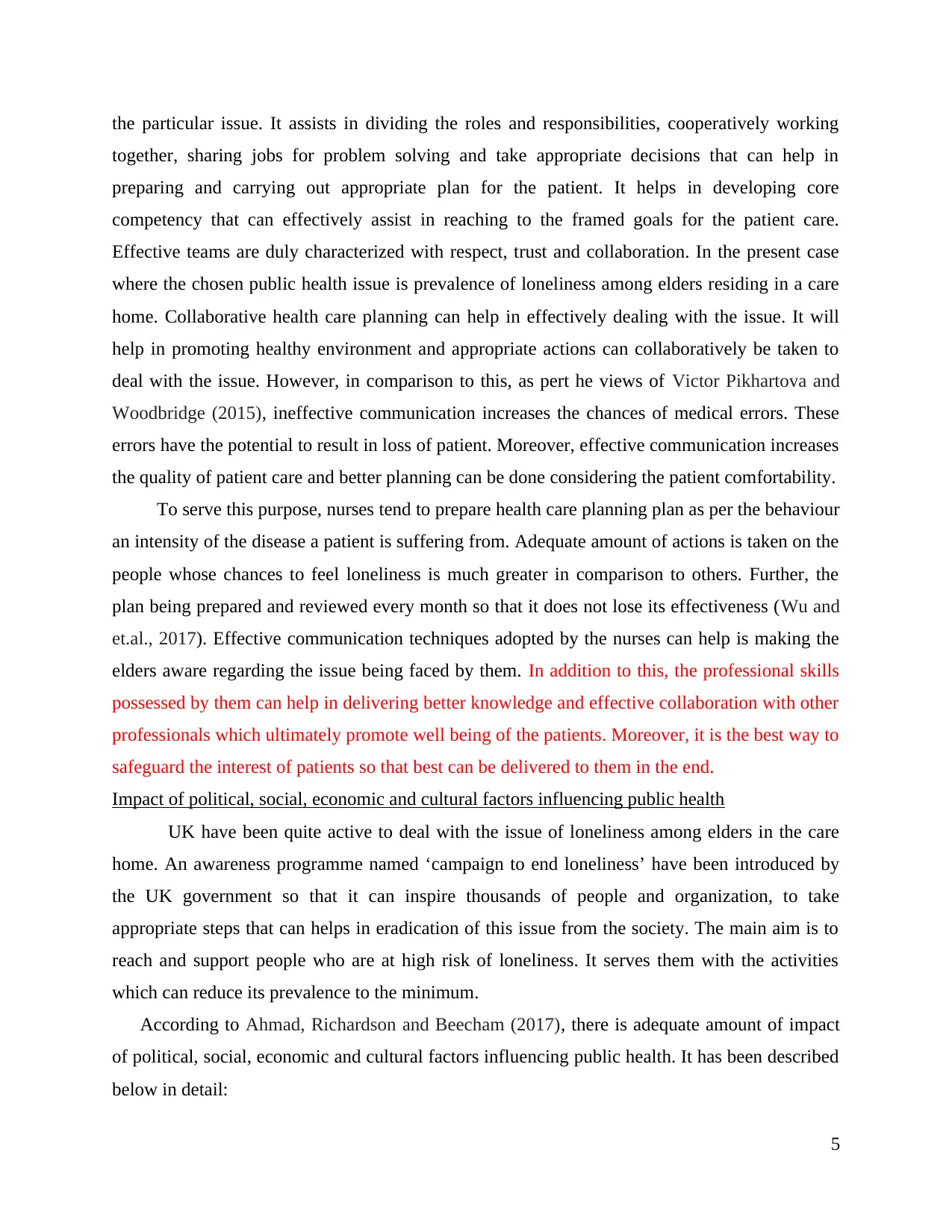
the particular issue. It assists in dividing the roles and responsibilities, cooperatively working
together, sharing jobs for problem solving and take appropriate decisions that can help in
preparing and carrying out appropriate plan for the patient. It helps in developing core
competency that can effectively assist in reaching to the framed goals for the patient care.
Effective teams are duly characterized with respect, trust and collaboration. In the present case
where the chosen public health issue is prevalence of loneliness among elders residing in a care
home. Collaborative health care planning can help in effectively dealing with the issue. It will
help in promoting healthy environment and appropriate actions can collaboratively be taken to
deal with the issue. However, in comparison to this, as pert he views of Victor Pikhartova and
Woodbridge (2015), ineffective communication increases the chances of medical errors. These
errors have the potential to result in loss of patient. Moreover, effective communication increases
the quality of patient care and better planning can be done considering the patient comfortability.
To serve this purpose, nurses tend to prepare health care planning plan as per the behaviour
an intensity of the disease a patient is suffering from. Adequate amount of actions is taken on the
people whose chances to feel loneliness is much greater in comparison to others. Further, the
plan being prepared and reviewed every month so that it does not lose its effectiveness (Wu and
et.al., 2017). Effective communication techniques adopted by the nurses can help is making the
elders aware regarding the issue being faced by them. In addition to this, the professional skills
possessed by them can help in delivering better knowledge and effective collaboration with other
professionals which ultimately promote well being of the patients. Moreover, it is the best way to
safeguard the interest of patients so that best can be delivered to them in the end.
Impact of political, social, economic and cultural factors influencing public health
UK have been quite active to deal with the issue of loneliness among elders in the care
home. An awareness programme named ‘campaign to end loneliness’ have been introduced by
the UK government so that it can inspire thousands of people and organization, to take
appropriate steps that can helps in eradication of this issue from the society. The main aim is to
reach and support people who are at high risk of loneliness. It serves them with the activities
which can reduce its prevalence to the minimum.
According to Ahmad, Richardson and Beecham (2017), there is adequate amount of impact
of political, social, economic and cultural factors influencing public health. It has been described
below in detail:
5
together, sharing jobs for problem solving and take appropriate decisions that can help in
preparing and carrying out appropriate plan for the patient. It helps in developing core
competency that can effectively assist in reaching to the framed goals for the patient care.
Effective teams are duly characterized with respect, trust and collaboration. In the present case
where the chosen public health issue is prevalence of loneliness among elders residing in a care
home. Collaborative health care planning can help in effectively dealing with the issue. It will
help in promoting healthy environment and appropriate actions can collaboratively be taken to
deal with the issue. However, in comparison to this, as pert he views of Victor Pikhartova and
Woodbridge (2015), ineffective communication increases the chances of medical errors. These
errors have the potential to result in loss of patient. Moreover, effective communication increases
the quality of patient care and better planning can be done considering the patient comfortability.
To serve this purpose, nurses tend to prepare health care planning plan as per the behaviour
an intensity of the disease a patient is suffering from. Adequate amount of actions is taken on the
people whose chances to feel loneliness is much greater in comparison to others. Further, the
plan being prepared and reviewed every month so that it does not lose its effectiveness (Wu and
et.al., 2017). Effective communication techniques adopted by the nurses can help is making the
elders aware regarding the issue being faced by them. In addition to this, the professional skills
possessed by them can help in delivering better knowledge and effective collaboration with other
professionals which ultimately promote well being of the patients. Moreover, it is the best way to
safeguard the interest of patients so that best can be delivered to them in the end.
Impact of political, social, economic and cultural factors influencing public health
UK have been quite active to deal with the issue of loneliness among elders in the care
home. An awareness programme named ‘campaign to end loneliness’ have been introduced by
the UK government so that it can inspire thousands of people and organization, to take
appropriate steps that can helps in eradication of this issue from the society. The main aim is to
reach and support people who are at high risk of loneliness. It serves them with the activities
which can reduce its prevalence to the minimum.
According to Ahmad, Richardson and Beecham (2017), there is adequate amount of impact
of political, social, economic and cultural factors influencing public health. It has been described
below in detail:
5
Paraphrase This Document
Need a fresh take? Get an instant paraphrase of this document with our AI Paraphraser
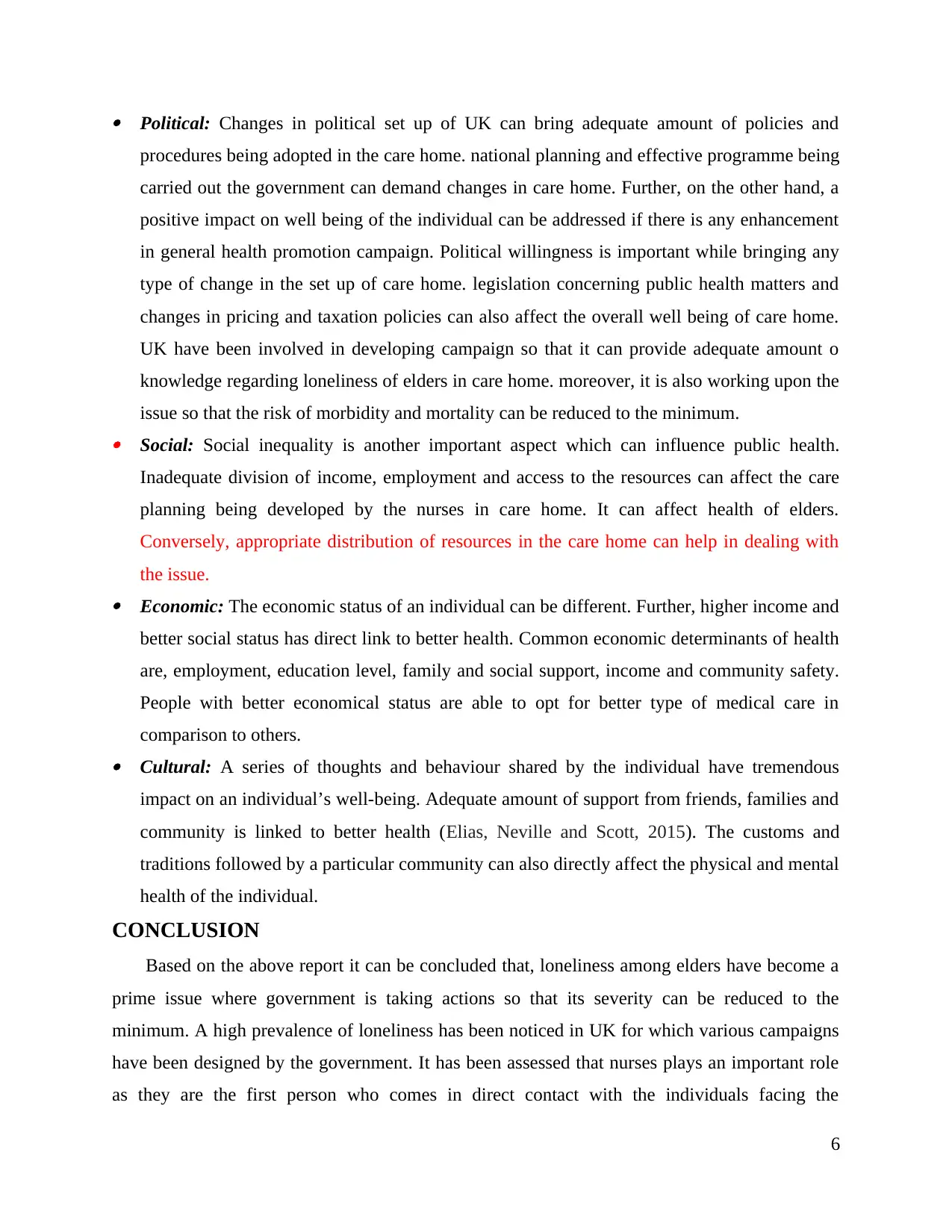
Political: Changes in political set up of UK can bring adequate amount of policies and
procedures being adopted in the care home. national planning and effective programme being
carried out the government can demand changes in care home. Further, on the other hand, a
positive impact on well being of the individual can be addressed if there is any enhancement
in general health promotion campaign. Political willingness is important while bringing any
type of change in the set up of care home. legislation concerning public health matters and
changes in pricing and taxation policies can also affect the overall well being of care home.
UK have been involved in developing campaign so that it can provide adequate amount o
knowledge regarding loneliness of elders in care home. moreover, it is also working upon the
issue so that the risk of morbidity and mortality can be reduced to the minimum. Social: Social inequality is another important aspect which can influence public health.
Inadequate division of income, employment and access to the resources can affect the care
planning being developed by the nurses in care home. It can affect health of elders.
Conversely, appropriate distribution of resources in the care home can help in dealing with
the issue. Economic: The economic status of an individual can be different. Further, higher income and
better social status has direct link to better health. Common economic determinants of health
are, employment, education level, family and social support, income and community safety.
People with better economical status are able to opt for better type of medical care in
comparison to others. Cultural: A series of thoughts and behaviour shared by the individual have tremendous
impact on an individual’s well-being. Adequate amount of support from friends, families and
community is linked to better health (Elias, Neville and Scott, 2015). The customs and
traditions followed by a particular community can also directly affect the physical and mental
health of the individual.
CONCLUSION
Based on the above report it can be concluded that, loneliness among elders have become a
prime issue where government is taking actions so that its severity can be reduced to the
minimum. A high prevalence of loneliness has been noticed in UK for which various campaigns
have been designed by the government. It has been assessed that nurses plays an important role
as they are the first person who comes in direct contact with the individuals facing the
6
procedures being adopted in the care home. national planning and effective programme being
carried out the government can demand changes in care home. Further, on the other hand, a
positive impact on well being of the individual can be addressed if there is any enhancement
in general health promotion campaign. Political willingness is important while bringing any
type of change in the set up of care home. legislation concerning public health matters and
changes in pricing and taxation policies can also affect the overall well being of care home.
UK have been involved in developing campaign so that it can provide adequate amount o
knowledge regarding loneliness of elders in care home. moreover, it is also working upon the
issue so that the risk of morbidity and mortality can be reduced to the minimum. Social: Social inequality is another important aspect which can influence public health.
Inadequate division of income, employment and access to the resources can affect the care
planning being developed by the nurses in care home. It can affect health of elders.
Conversely, appropriate distribution of resources in the care home can help in dealing with
the issue. Economic: The economic status of an individual can be different. Further, higher income and
better social status has direct link to better health. Common economic determinants of health
are, employment, education level, family and social support, income and community safety.
People with better economical status are able to opt for better type of medical care in
comparison to others. Cultural: A series of thoughts and behaviour shared by the individual have tremendous
impact on an individual’s well-being. Adequate amount of support from friends, families and
community is linked to better health (Elias, Neville and Scott, 2015). The customs and
traditions followed by a particular community can also directly affect the physical and mental
health of the individual.
CONCLUSION
Based on the above report it can be concluded that, loneliness among elders have become a
prime issue where government is taking actions so that its severity can be reduced to the
minimum. A high prevalence of loneliness has been noticed in UK for which various campaigns
have been designed by the government. It has been assessed that nurses plays an important role
as they are the first person who comes in direct contact with the individuals facing the
6

deteriorating health issues through it. Hence, giving appropriate support to the people can help in
combating the issue.
7
combating the issue.
7
⊘ This is a preview!⊘
Do you want full access?
Subscribe today to unlock all pages.

Trusted by 1+ million students worldwide
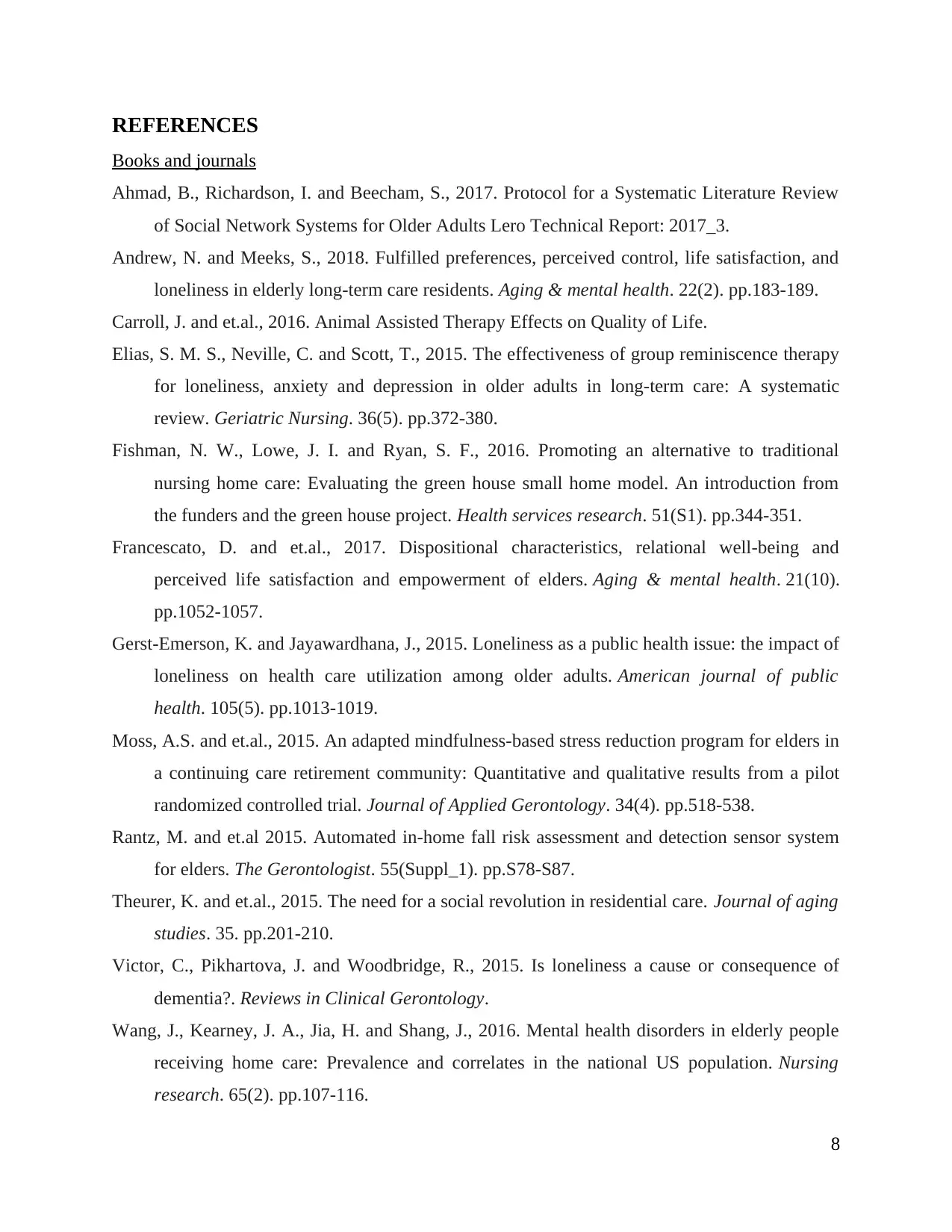
REFERENCES
Books and journals
Ahmad, B., Richardson, I. and Beecham, S., 2017. Protocol for a Systematic Literature Review
of Social Network Systems for Older Adults Lero Technical Report: 2017_3.
Andrew, N. and Meeks, S., 2018. Fulfilled preferences, perceived control, life satisfaction, and
loneliness in elderly long-term care residents. Aging & mental health. 22(2). pp.183-189.
Carroll, J. and et.al., 2016. Animal Assisted Therapy Effects on Quality of Life.
Elias, S. M. S., Neville, C. and Scott, T., 2015. The effectiveness of group reminiscence therapy
for loneliness, anxiety and depression in older adults in long-term care: A systematic
review. Geriatric Nursing. 36(5). pp.372-380.
Fishman, N. W., Lowe, J. I. and Ryan, S. F., 2016. Promoting an alternative to traditional
nursing home care: Evaluating the green house small home model. An introduction from
the funders and the green house project. Health services research. 51(S1). pp.344-351.
Francescato, D. and et.al., 2017. Dispositional characteristics, relational well-being and
perceived life satisfaction and empowerment of elders. Aging & mental health. 21(10).
pp.1052-1057.
Gerst-Emerson, K. and Jayawardhana, J., 2015. Loneliness as a public health issue: the impact of
loneliness on health care utilization among older adults. American journal of public
health. 105(5). pp.1013-1019.
Moss, A.S. and et.al., 2015. An adapted mindfulness-based stress reduction program for elders in
a continuing care retirement community: Quantitative and qualitative results from a pilot
randomized controlled trial. Journal of Applied Gerontology. 34(4). pp.518-538.
Rantz, M. and et.al 2015. Automated in-home fall risk assessment and detection sensor system
for elders. The Gerontologist. 55(Suppl_1). pp.S78-S87.
Theurer, K. and et.al., 2015. The need for a social revolution in residential care. Journal of aging
studies. 35. pp.201-210.
Victor, C., Pikhartova, J. and Woodbridge, R., 2015. Is loneliness a cause or consequence of
dementia?. Reviews in Clinical Gerontology.
Wang, J., Kearney, J. A., Jia, H. and Shang, J., 2016. Mental health disorders in elderly people
receiving home care: Prevalence and correlates in the national US population. Nursing
research. 65(2). pp.107-116.
8
Books and journals
Ahmad, B., Richardson, I. and Beecham, S., 2017. Protocol for a Systematic Literature Review
of Social Network Systems for Older Adults Lero Technical Report: 2017_3.
Andrew, N. and Meeks, S., 2018. Fulfilled preferences, perceived control, life satisfaction, and
loneliness in elderly long-term care residents. Aging & mental health. 22(2). pp.183-189.
Carroll, J. and et.al., 2016. Animal Assisted Therapy Effects on Quality of Life.
Elias, S. M. S., Neville, C. and Scott, T., 2015. The effectiveness of group reminiscence therapy
for loneliness, anxiety and depression in older adults in long-term care: A systematic
review. Geriatric Nursing. 36(5). pp.372-380.
Fishman, N. W., Lowe, J. I. and Ryan, S. F., 2016. Promoting an alternative to traditional
nursing home care: Evaluating the green house small home model. An introduction from
the funders and the green house project. Health services research. 51(S1). pp.344-351.
Francescato, D. and et.al., 2017. Dispositional characteristics, relational well-being and
perceived life satisfaction and empowerment of elders. Aging & mental health. 21(10).
pp.1052-1057.
Gerst-Emerson, K. and Jayawardhana, J., 2015. Loneliness as a public health issue: the impact of
loneliness on health care utilization among older adults. American journal of public
health. 105(5). pp.1013-1019.
Moss, A.S. and et.al., 2015. An adapted mindfulness-based stress reduction program for elders in
a continuing care retirement community: Quantitative and qualitative results from a pilot
randomized controlled trial. Journal of Applied Gerontology. 34(4). pp.518-538.
Rantz, M. and et.al 2015. Automated in-home fall risk assessment and detection sensor system
for elders. The Gerontologist. 55(Suppl_1). pp.S78-S87.
Theurer, K. and et.al., 2015. The need for a social revolution in residential care. Journal of aging
studies. 35. pp.201-210.
Victor, C., Pikhartova, J. and Woodbridge, R., 2015. Is loneliness a cause or consequence of
dementia?. Reviews in Clinical Gerontology.
Wang, J., Kearney, J. A., Jia, H. and Shang, J., 2016. Mental health disorders in elderly people
receiving home care: Prevalence and correlates in the national US population. Nursing
research. 65(2). pp.107-116.
8
Paraphrase This Document
Need a fresh take? Get an instant paraphrase of this document with our AI Paraphraser
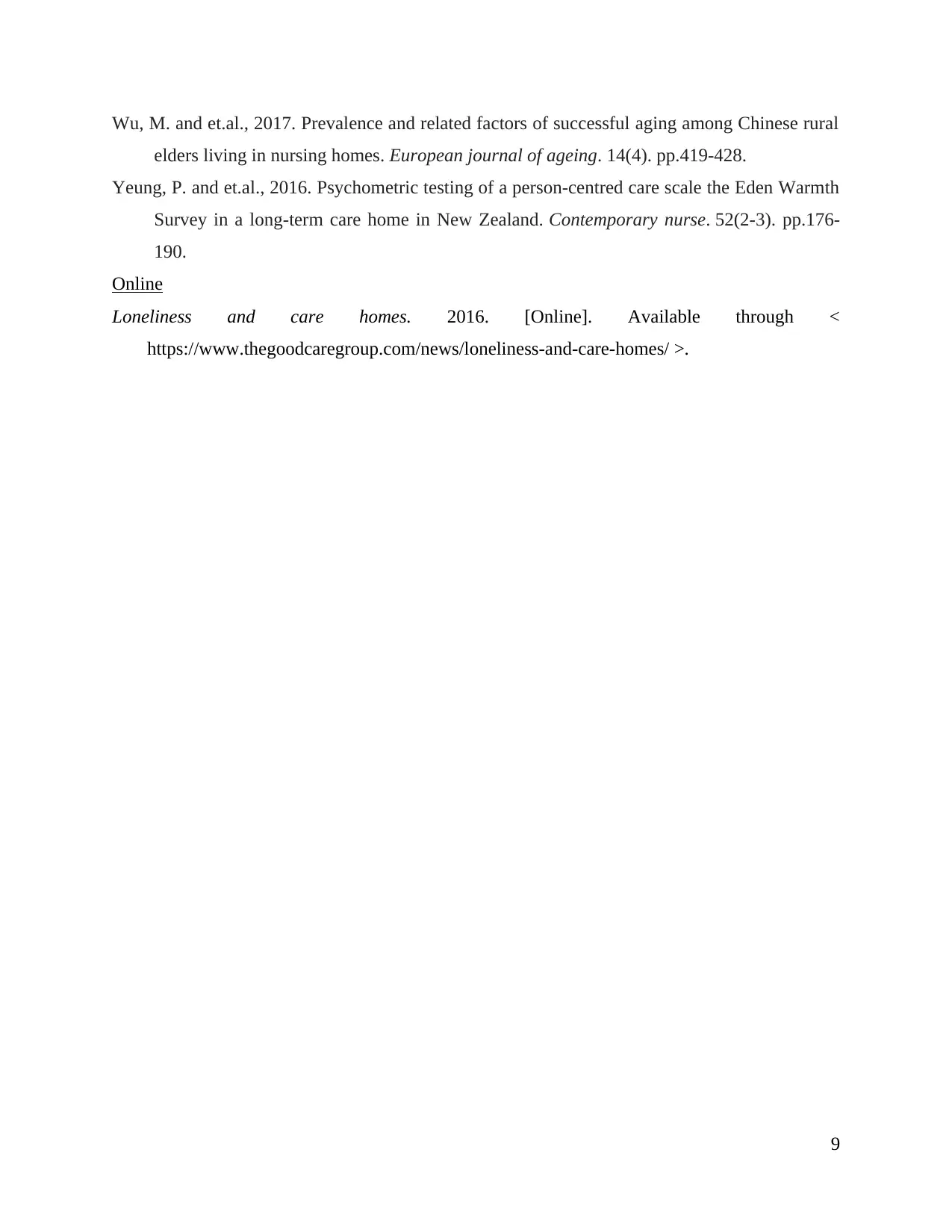
Wu, M. and et.al., 2017. Prevalence and related factors of successful aging among Chinese rural
elders living in nursing homes. European journal of ageing. 14(4). pp.419-428.
Yeung, P. and et.al., 2016. Psychometric testing of a person-centred care scale the Eden Warmth
Survey in a long-term care home in New Zealand. Contemporary nurse. 52(2-3). pp.176-
190.
Online
Loneliness and care homes. 2016. [Online]. Available through <
https://www.thegoodcaregroup.com/news/loneliness-and-care-homes/ >.
9
elders living in nursing homes. European journal of ageing. 14(4). pp.419-428.
Yeung, P. and et.al., 2016. Psychometric testing of a person-centred care scale the Eden Warmth
Survey in a long-term care home in New Zealand. Contemporary nurse. 52(2-3). pp.176-
190.
Online
Loneliness and care homes. 2016. [Online]. Available through <
https://www.thegoodcaregroup.com/news/loneliness-and-care-homes/ >.
9
1 out of 11
Related Documents
Your All-in-One AI-Powered Toolkit for Academic Success.
+13062052269
info@desklib.com
Available 24*7 on WhatsApp / Email
![[object Object]](/_next/static/media/star-bottom.7253800d.svg)
Unlock your academic potential
Copyright © 2020–2025 A2Z Services. All Rights Reserved. Developed and managed by ZUCOL.





